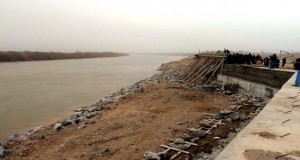Hasaka, SANA Syria is rich in water resources, mainly rivers and lakes. The Euphrates River, which flows from Turkey through Syria and neighboring Iraq, is considered the longest and most important river in Syria, while Tigris River, which also flows from Turkey, passes only partly in Syria.
Other important rivers include the Orontes in the central Hama province, Barada in Damascus and Yarmouk in the southern region.
The abundance of water resources in Syria has boosted the country’s agricultural production, with agriculture making 25 % of the GDP. That’s why establishing water drawing projects has been a vital interest for the bodies concerned.
Chief among those projects, whose implementation has unfortunately been delayed, is the one planned on Tigris River to draw water to the northeastern Hasaka province.
The river flows for 400 km through Turkish territory before becoming the border between Syria and Turkey. This stretch of 44 km is the only part of the river that is located in Syria.
The project is one of the strategic development projects in Syria. Yet, the implementation delay has been prompted by the terrorist war waged against Syria and the spread of terrorist organizations in various areas across the country, including in northern and eastern regions.
Drawing water from Tigris is a “dream project” for the locals of Hasaka given its importance for easing the impacts of the drought affecting the province over the last few years.
The project, once accomplished, would contribute to providing water irrigation for the villages and agricultural lands in Hasaka, in addition to reviving al-Khabur River, which also flows from Turkey and crosses the border southward into Raas al-Eyn in northeastern Syria.
In 2011, President Bashar al-Assad laid the foundation stone for the project, whose estimated cost is over SYP 100 billion, according to Director of the Water Resources Directorate of Hasaka, eng. Abdul-Razzaq al-Awaq.
The project aims at drawing 1.25 billion cubic meters of water from the Tigris River to Hasaka province, irrigating 200,00 hectares of land and providing 125 million cubic meters of drinking water per year, in addition to supporting al-Khabur river irrigation networks which irrigate 63,000 hectares.

The project consists of Ein Diwar water pumping station and Ein Diwar channel. According to the project’s study, the station will discharge water at a rate of 10/ 100 cubic meters per second.
The Ein Diwar Channel will be bifurcated into two canals; the first one will head towards al -Safan dam in al-Malkiyeh city and the other one towards the Krachuq Mountain.
The Krachuq canal will be divided into M1 canal, with a length of 72km, and M2 canal, with a length of 29km, where the M1 canal is scheduled to discharge water in April 7th and March 8th dams, while the M2 canal will pump water in al-Bassel Dam to the south of Hasaka city on al- Khabur River.
The project was scheduled to be completed in 2015, but it was decelerated as the terrorists’ organizations stole its equipment, al-Awaq told SANA.
He referred to other contracted projects, including the one aimed at rehabilitating al-
Khabur old irrigation network, noting that the Ministry of Water Resources inked a contract with the Russian Story Trans Gas Company to carry out the main pumping station on the Tigris River at Ein Diwar site.
Director of Hasaka Agriculture Department Eng. Amer Sallo said the project, once invested, will increase the percentage of irrigated lands by further 200,000 hectares, which would consequently increase the province’s production of strategic crops, in addition to providing tens of thousands of job opportunities to peasants who abandoned their farming work due to the drought.
Hasaka province is a governorate in the far north-east corner of Syria. It is distinguished by its fertile lands, plentiful water, picturesque nature, and more than one hundred archaeological sites. It was formerly known as al-Jazira province
It is considered one of the most important regions in Syria as it is a main producer of oil, cotton, wheat, barley and lentils, in addition to dozens of other crops.
Grazing and raising livestock such as sheep, goats, cows and chicken are also main sources of living in the province.
H. Zain/H. Said
 Syrian Arab News Agency S A N A
Syrian Arab News Agency S A N A


